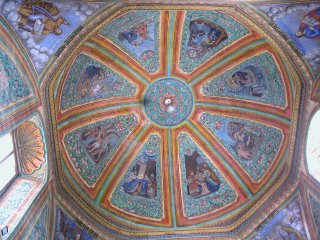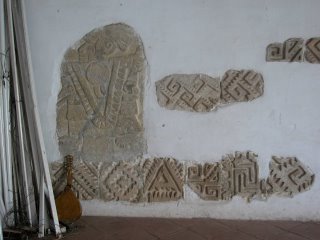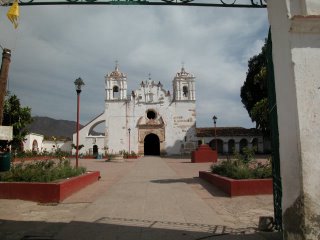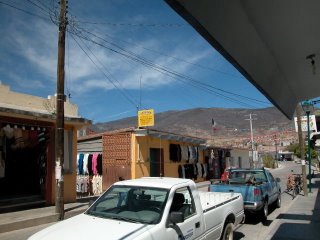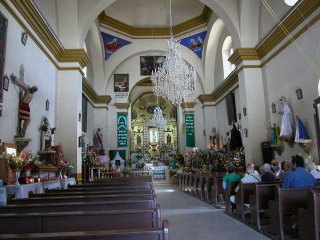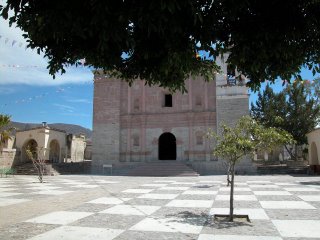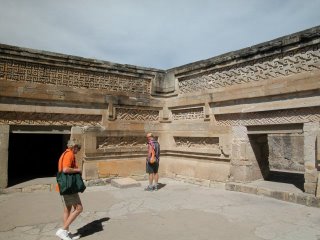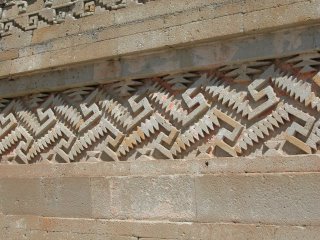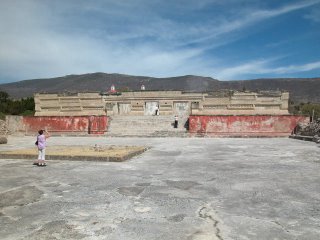Mexico Travelogue
We have been married 34 years and are pretty much an inseparable team. With four children long gone from the nest, we are now contemplating retirement and are travelling more and more in our favourite destination; Mexico. Ultimately we hope to retire in a colonial city in the centre of Mexico and are spending long periods of time in as many as possible. We hope to bring you interesting stories and full articles on life south of the Rio. Please give us your feedback
Sunday, February 05, 2006
Exploring the Hinterland of Oaxaca
Exploring the Hinterland
February 3, 2006
The hinterland surrounding the city of Oaxaca provides weeks of opportunities to go exploring. Travel in any compass direction and you will come across scores of little villages with big attractions. With the end of our Spanish lessons, we decided to start touring. Most tourists rely on travel agencies, tour guides or the intercity bus system to get them to and from points of interest. Since there were four of us to split the expense, we chose travel by taxi as a more convenient option. It was a good choice since we could explore at our own pace and soak up as much or as little as we wished.
Thus, on this Friday morning we hired a cab to drive us 50 kilometres to the town of Mitla, a well-known archaeological site dating from about 400AD. We had previously visited Monte Alban and were able to compare developments of indigenous architecture from different time periods. We were also able to get a sense of the impact of the Spanish conquest on the native culture.
There are two striking features of Monte Alban that contrast with Mitla. Monte Alban is huge and it was never discovered by the Spaniards since it had long before been abandoned to mother nature. Mitla was a thriving town at the time of the conquest and was quickly put under the control of the conquistadors and the Catholic Church. Much of the old city was destroyed to eradicate native religious influences and as a quick way to provide building materials for Christian churches and other Spanish style buildings. Fortunately enough of the old city remains to provide a dazzling display of pre-Columbian architecture.
Though lacking in size and quantity, Mitla has a substantial charm flowing from inlaid stone panelling that covers the exterior and interior walls and of the buildings. These panels are extraordinarily intricate and none are the same. The buildings also appear to have much greater functionality to the extent that they contain usable rooms. The Monte Alban buildings were fundamentally monuments of pyramid proportions that were used for ritualistic purposes. Perhaps the Catholic Church destroyed similar buildings at Mitla leaving only commercial and administrative buildings that could serve the purposes of the Spaniards equally well.
Plunked right in the middle of the Mitla ruins is the original Catholic Church built with the stones of demolished native structures. It is a very substantial building and towers over the rest of the site. It is in excellent condition and has obviously been restored in recent years.
Mitla is worth a visit just to see the detailed friezes on the few restored building. It lacks the awe-inspiring grandeur and isolation of Monte Alban. Mitla is not in an isolated spot. It is completely contained within the still living town of the same name. Immediately upon leaving the site, you walk into the central business district of the town. It is a vibrant little place of about 5000 surrounded by high mountains. We spent an hour exploring the streets and shops before eating a traditional Mexican lunch (comida corrida) at a local restaurant.
After lunch, we found another taxi and headed for Teotitlan de Valle, a dusty little village of 5000 people famous for the weaving of woollen rugs and cotton goods such as bedspreads, table cloths and shawls. We exited the cab at the crossroads of the two main streets and wandered towards the stores offering goods for sale. There were three or four shops of some substance but most of the merchandise was being sold from crudely constructed three sided huts all attached one to the other.
For the quality and variety of the merchandise available in this town, the marketing was atrocious. It had the feel of a country circus with hustlers at each stall. Nobody spoke any English and there was no literature on the origins, the manufacturing process or the quality of the goods on offer.
From my readings on Teotitlan and its weavers, I had learned a great deal about the gargantuan efforts of the people making these products. The dyes are obtained from nature in the form of flowers, roots, berries and worms. The bright red dye is manufactured from hundreds of thousands of small worms that are picked off maguey plants, dried, ground and then added to water. A hundred thousand worms may yield a pound of dye. The water used to mix the dye has to be pure and hundreds of people head into the hills every couple of days to find pure water and haul it back to the village. The weaving is done on old-fashioned looms introduced by the Spaniards some 500 years ago. At the end of this process an exquisite wool rug of 6 feet by 3 feet may sell at an asking price of $50US. A beautiful cotton shawl will go for $20 without any haggling. On top of this, tour companies that bring groups to artisan stores demand and get a forty percent commission on everything sold to their group.
In our visit to Teotitlan, we never did see any of the productions process. We never saw anyone weaving, or making dye or carding wool. I, personally, would be fascinated to see the process and would gladly pay someone to show me around. There was no such service offered. Here were world-class products being marketed with Stone Age methods. For a very small investment by the government, the services offered by the Teotitlan weavers and their incomes could be greatly enhanced. Even a simple handout that gave translations for important words like rug or shawl as well as colours would help immensely. If you go into a shop looking for a rug, you might be shown a shawl or a table spread. If you want blue you will end up being shown every colour in the rainbow. Products would be strewn all over the floor.
How simple it would be to have a translation service, an audio-visual display of the production process, a little lecture on knowing the difference between artificial dyes and natural dyes. In Oaxaca last week, I attended the 6th annual Rural Tourism Fair. It was designed as a means for rural artisans to communicate with the business community and the buying public in order to enhance their marketing skills. I was overwhelmed by how boring and useless this fair was. The displays by the artisans, who offered a wide variety of products, were pretty basic given the limited space available but I couldn’t communicate with any of these people. There was an essential disconnect between the objectives of the artisans to sell some product and the organizers intent on creating a forum of communications to enhance marketing. I know that it is highly democratic to involve everyone in discussions, but ultimately someone has to take the toro by the horns and do something constructive.
Consider this. It costs $2 per person to go by cab from Oaxaca to Teotitlan for a party of four. If the merchant weavers offered the same cab service daily from a central location with a full tour of the production process for $10, they could make an extra $8 per person or $40 per cab and I bet those customers would buy more products. The customers would be in town longer and would need more services like food and beverages and on top of that, the weavers wouldn’t be paying a forty percent commission to tour guides. With just a little imagination, so much could be achieved with little effort. Perhaps there is a marketing expert who would enjoy a vacation in Oaxaca while volunteering to design and implement a basic marketing program for the weavers of Teotitlan. Great strides in economic development can be achieved without initiatives of a World Bank scale.
After our brief tour of the weaving shops, we ambled around town looking at other sites. There is quite an interesting little museum that offers a history of the weaving industry, a pictorial display of social customs and some artifacts from the pre-Spanish era. For a small town, it is well done and is a good example of an initiative to bring more money to the community.
Uphill and behind the weavers market we found a large Catholic Church dating from 1751. The building was in the restoration process with half of the work completed. The interior and exterior walls of the church were finished with a white stucco that had been exposed in several places to reveal the stonework beneath. It was clear that the stone had been taken from pre-Columbian buildings. Intricate carving details similar to those found at Mitla where fully exposed. The local residents were genuinely proud of their ancestral heritage and I was reminded of the Mexican understanding that BC means “before Cortez.”
Beside the church was a large mercado in the early stages of set-up for the Saturday market. A cornucopia of fruits and vegetables were already on display and we purchased a few bananas to tide us over until our next feeding. While eating, we discussed going into the upper reaches of the mountains that flanked the south side of the village. According to a topographic map in the museum, there were several towns located at the ten thousand foot elevation and accessible by a very serpentine roadway. The villages appeared to be roughly five miles as the crow flies but more than likely twenty miles based on the twisting and turning shown on the map. We hailed a cab but were left with no doubt as to the driver’s interest in trekking to the upper reaches of Mexico. The proposed cab fare included the replacement of his vehicle that was more than we wanted to spend. Thus, we headed to Santa Maria del Tule to have a second look at the great Tule tree.
Santa Maria del Tule is a very pretty town essentially built around its famous tree. Owing to arid conditions at this time of year, it is unusual to see carefully manicured lawns in any park area but Santa Maria has an abundance as well as deftly carved topiary. It offers a pleasant walk but by this time we were much in need of liquid refreshments in a place without sun. We found a nice restaurant but the noise from some chap selling CDs outside the door forced us to seek refuge elsewhere. We ended up in a covered market, sat on wooden benches, watched the sights and inhaled a couple of Corona each before catching a cab back to Oaxaca.
In total we were on the road for seven hours, had spent $40 on cab fares, had a thoroughly good time and were ready for siesta. We can now look forward to exploring the other points on the compass as the weeks go by.
February 3, 2006
The hinterland surrounding the city of Oaxaca provides weeks of opportunities to go exploring. Travel in any compass direction and you will come across scores of little villages with big attractions. With the end of our Spanish lessons, we decided to start touring. Most tourists rely on travel agencies, tour guides or the intercity bus system to get them to and from points of interest. Since there were four of us to split the expense, we chose travel by taxi as a more convenient option. It was a good choice since we could explore at our own pace and soak up as much or as little as we wished.
Thus, on this Friday morning we hired a cab to drive us 50 kilometres to the town of Mitla, a well-known archaeological site dating from about 400AD. We had previously visited Monte Alban and were able to compare developments of indigenous architecture from different time periods. We were also able to get a sense of the impact of the Spanish conquest on the native culture.
There are two striking features of Monte Alban that contrast with Mitla. Monte Alban is huge and it was never discovered by the Spaniards since it had long before been abandoned to mother nature. Mitla was a thriving town at the time of the conquest and was quickly put under the control of the conquistadors and the Catholic Church. Much of the old city was destroyed to eradicate native religious influences and as a quick way to provide building materials for Christian churches and other Spanish style buildings. Fortunately enough of the old city remains to provide a dazzling display of pre-Columbian architecture.
Though lacking in size and quantity, Mitla has a substantial charm flowing from inlaid stone panelling that covers the exterior and interior walls and of the buildings. These panels are extraordinarily intricate and none are the same. The buildings also appear to have much greater functionality to the extent that they contain usable rooms. The Monte Alban buildings were fundamentally monuments of pyramid proportions that were used for ritualistic purposes. Perhaps the Catholic Church destroyed similar buildings at Mitla leaving only commercial and administrative buildings that could serve the purposes of the Spaniards equally well.
Plunked right in the middle of the Mitla ruins is the original Catholic Church built with the stones of demolished native structures. It is a very substantial building and towers over the rest of the site. It is in excellent condition and has obviously been restored in recent years.
Mitla is worth a visit just to see the detailed friezes on the few restored building. It lacks the awe-inspiring grandeur and isolation of Monte Alban. Mitla is not in an isolated spot. It is completely contained within the still living town of the same name. Immediately upon leaving the site, you walk into the central business district of the town. It is a vibrant little place of about 5000 surrounded by high mountains. We spent an hour exploring the streets and shops before eating a traditional Mexican lunch (comida corrida) at a local restaurant.
After lunch, we found another taxi and headed for Teotitlan de Valle, a dusty little village of 5000 people famous for the weaving of woollen rugs and cotton goods such as bedspreads, table cloths and shawls. We exited the cab at the crossroads of the two main streets and wandered towards the stores offering goods for sale. There were three or four shops of some substance but most of the merchandise was being sold from crudely constructed three sided huts all attached one to the other.
For the quality and variety of the merchandise available in this town, the marketing was atrocious. It had the feel of a country circus with hustlers at each stall. Nobody spoke any English and there was no literature on the origins, the manufacturing process or the quality of the goods on offer.
From my readings on Teotitlan and its weavers, I had learned a great deal about the gargantuan efforts of the people making these products. The dyes are obtained from nature in the form of flowers, roots, berries and worms. The bright red dye is manufactured from hundreds of thousands of small worms that are picked off maguey plants, dried, ground and then added to water. A hundred thousand worms may yield a pound of dye. The water used to mix the dye has to be pure and hundreds of people head into the hills every couple of days to find pure water and haul it back to the village. The weaving is done on old-fashioned looms introduced by the Spaniards some 500 years ago. At the end of this process an exquisite wool rug of 6 feet by 3 feet may sell at an asking price of $50US. A beautiful cotton shawl will go for $20 without any haggling. On top of this, tour companies that bring groups to artisan stores demand and get a forty percent commission on everything sold to their group.
In our visit to Teotitlan, we never did see any of the productions process. We never saw anyone weaving, or making dye or carding wool. I, personally, would be fascinated to see the process and would gladly pay someone to show me around. There was no such service offered. Here were world-class products being marketed with Stone Age methods. For a very small investment by the government, the services offered by the Teotitlan weavers and their incomes could be greatly enhanced. Even a simple handout that gave translations for important words like rug or shawl as well as colours would help immensely. If you go into a shop looking for a rug, you might be shown a shawl or a table spread. If you want blue you will end up being shown every colour in the rainbow. Products would be strewn all over the floor.
How simple it would be to have a translation service, an audio-visual display of the production process, a little lecture on knowing the difference between artificial dyes and natural dyes. In Oaxaca last week, I attended the 6th annual Rural Tourism Fair. It was designed as a means for rural artisans to communicate with the business community and the buying public in order to enhance their marketing skills. I was overwhelmed by how boring and useless this fair was. The displays by the artisans, who offered a wide variety of products, were pretty basic given the limited space available but I couldn’t communicate with any of these people. There was an essential disconnect between the objectives of the artisans to sell some product and the organizers intent on creating a forum of communications to enhance marketing. I know that it is highly democratic to involve everyone in discussions, but ultimately someone has to take the toro by the horns and do something constructive.
Consider this. It costs $2 per person to go by cab from Oaxaca to Teotitlan for a party of four. If the merchant weavers offered the same cab service daily from a central location with a full tour of the production process for $10, they could make an extra $8 per person or $40 per cab and I bet those customers would buy more products. The customers would be in town longer and would need more services like food and beverages and on top of that, the weavers wouldn’t be paying a forty percent commission to tour guides. With just a little imagination, so much could be achieved with little effort. Perhaps there is a marketing expert who would enjoy a vacation in Oaxaca while volunteering to design and implement a basic marketing program for the weavers of Teotitlan. Great strides in economic development can be achieved without initiatives of a World Bank scale.
After our brief tour of the weaving shops, we ambled around town looking at other sites. There is quite an interesting little museum that offers a history of the weaving industry, a pictorial display of social customs and some artifacts from the pre-Spanish era. For a small town, it is well done and is a good example of an initiative to bring more money to the community.
Uphill and behind the weavers market we found a large Catholic Church dating from 1751. The building was in the restoration process with half of the work completed. The interior and exterior walls of the church were finished with a white stucco that had been exposed in several places to reveal the stonework beneath. It was clear that the stone had been taken from pre-Columbian buildings. Intricate carving details similar to those found at Mitla where fully exposed. The local residents were genuinely proud of their ancestral heritage and I was reminded of the Mexican understanding that BC means “before Cortez.”
Beside the church was a large mercado in the early stages of set-up for the Saturday market. A cornucopia of fruits and vegetables were already on display and we purchased a few bananas to tide us over until our next feeding. While eating, we discussed going into the upper reaches of the mountains that flanked the south side of the village. According to a topographic map in the museum, there were several towns located at the ten thousand foot elevation and accessible by a very serpentine roadway. The villages appeared to be roughly five miles as the crow flies but more than likely twenty miles based on the twisting and turning shown on the map. We hailed a cab but were left with no doubt as to the driver’s interest in trekking to the upper reaches of Mexico. The proposed cab fare included the replacement of his vehicle that was more than we wanted to spend. Thus, we headed to Santa Maria del Tule to have a second look at the great Tule tree.
Santa Maria del Tule is a very pretty town essentially built around its famous tree. Owing to arid conditions at this time of year, it is unusual to see carefully manicured lawns in any park area but Santa Maria has an abundance as well as deftly carved topiary. It offers a pleasant walk but by this time we were much in need of liquid refreshments in a place without sun. We found a nice restaurant but the noise from some chap selling CDs outside the door forced us to seek refuge elsewhere. We ended up in a covered market, sat on wooden benches, watched the sights and inhaled a couple of Corona each before catching a cab back to Oaxaca.
In total we were on the road for seven hours, had spent $40 on cab fares, had a thoroughly good time and were ready for siesta. We can now look forward to exploring the other points on the compass as the weeks go by.




